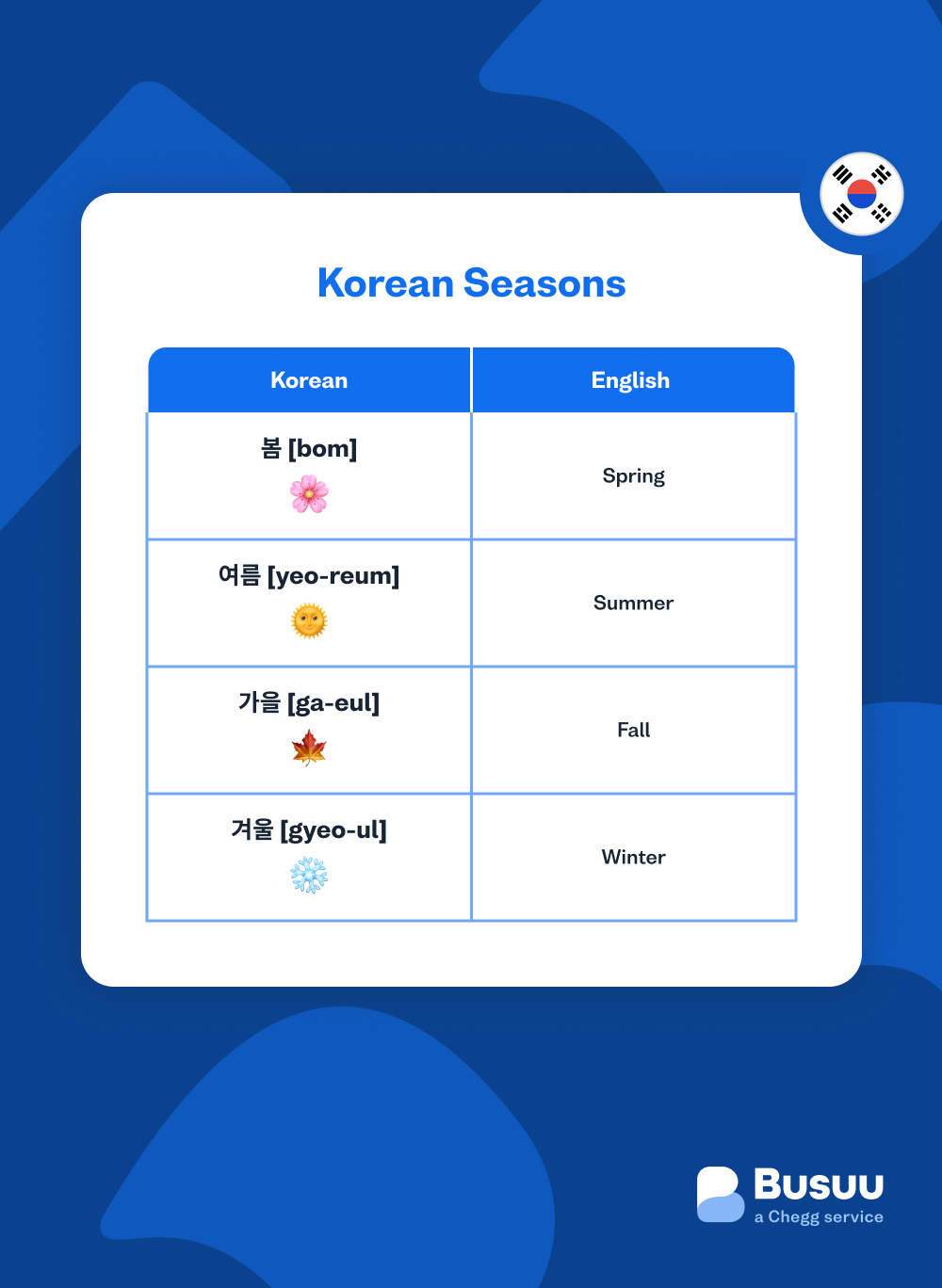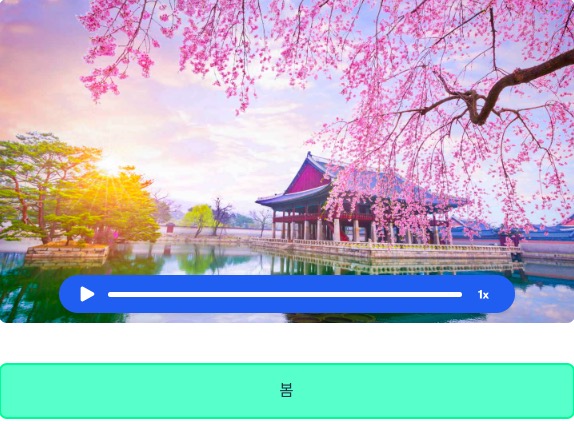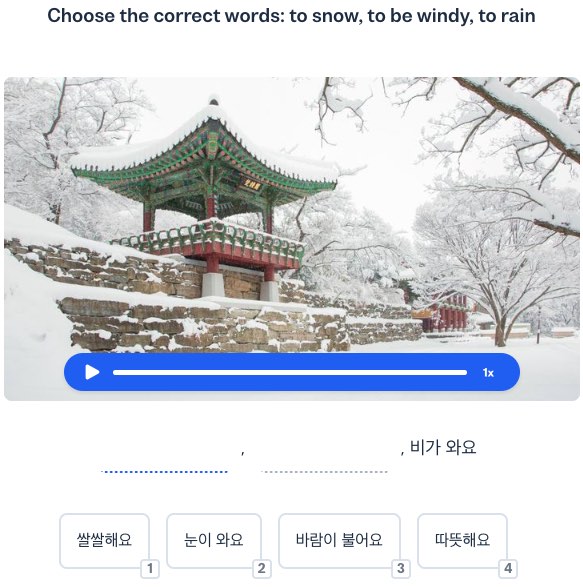Seasons in Korean
Let’s learn about the different seasons in Korea!
‘Season’ in Korean is 계절 [gye-jeol], and Korea has four distinct seasons. To say ‘four seasons’ in Korean, we say 사계절 [sa-gye-jeol], and 사 simply means ‘four’. Summer can get very hot and humid while winter can be extremely cold and snowy, and these two seasons are sandwiched by the mild weather of spring and fall.
Let’s learn about the four distinct Korean seasons.

Korean spring
‘Spring’ in Korean is 봄 [bom]. 봄 begins in March, and after the pretty extreme cold weather of winter, the weather warms up and many flowers begin to bloom in spring. The Korean national flower is 무궁화 [mu-gung-hwa], rose of Sharon.
The flower’s name, 무궁화, was made famous by the drama series Squid Game as the Red Light, Green Light game in the drama uses the name 무궁화. The game is played by singing the line “무궁화 꽃이 피었습니다”, which means “Rose of Sharon has bloomed”.
Another flower that’s very popular in spring is 벚꽃 [beot-kkot], cherry blossom. In March and April, there are numerous cherry blossom festivals all over Korea. In Seoul, two most famous festivals are in 여의도 [yeo-ui-do] and 석촌 호수 [Seok-chon ho-su]. However, the most famous festival is in 진해 군항제 [Jin-hae gun-hang-je]. 진해 is a city on the south coast, and during the festival, the entire city is covered with cherry blossom.
Common flower names in Korean
| Korean | Romanization | English |
|---|---|---|
| 무궁화 | [mu-gung-hwa] | rose of Sharon |
| 벚꽃 | [beot-kkot] | cherry blossom |
| 진달래 | [jin-dal-lae] | azalea |
| 장미 | [jang-mi] | rose |
| 국화 | [guk-hwa] | chrysanthemum |
| 해바라기 | [hae-ba-ra-gi] | sunflower |
| 매화 | [mae-hwa] | plum blossom |
| 백합 | [baek-hap] | lily |
An important day in spring is Arbor Day. Arbor Day in Korean is 식목일 [sing-mo-gil], and it’s on April 5th. 식목일 was a public holiday in Korea until 2005. Another important part of spring is that unlike many other countries like the US, the Korean school year begins in March. So at the end of the cold winter, the beginning of March marks the start of a new school year.
Spring vocabulary in Korean
| Korean | Romanization | English |
|---|---|---|
| 꽃이 피다 | [kkot-i pi-da] | flower blooms |
| 꽃향기 | [kkot-hyang-gi] | floral scent |
| 꽃잎 | [kkon-nip] | petal |
| 나무 | [na-mu] | tree |
| 나무를 심다 | [na-mu] | to plant a tree |
| 개학 | [gae-hak] | first day of school |
| 새 학년 | [sae-hak-nyeon] | new school year |
| 소풍 | [so-pung] | picnic |
Spring weather vocabulary in Korean
| Korean | Romanization | English |
|---|---|---|
| 날씨 | [nal-ssi] | weather |
| 하늘 | [ha-neul] | sky |
| 서늘하다 | [seo-neul-ha-da] | to be cool / chilly |
| 시원하다 | [si-won-ha-da] | to be cool |
| 화창하다 | [hwa-chang-ha-da] | to be sunny |
| 맑다 | [mak-da] | to be clear |
| 따뜻하다 | [tta-tteut-ha-da] | to be warm |
Useful sentences to describe the spring weather:
- 한국은 봄에 날씨가 서늘해요. [Han-guk-eun bom-e nal-ssi-ga seo-neul-hae-yo.] - Spring weather in South Korea is cool.
- 날씨가 화창해요. [Nal-ssi-ga hwa-chang-hae-yo.] - The weather is sunny.
- 날씨가 따뜻해요. [Nal-ssi-ga tta-tteut-hae-yo.] - The weather is warm.
- 하늘이 맑아요. [Ha-neul-i mal-ga-yo.] - The sky is clear. / The weather is clear.
Korean summer
‘Summer’ in Korean is 여름 [yeo-reum]. 여름 begins in June, when the weather starts to warm up and by July it gets very hot and humid.
At the end of June, we have the monsoon season. ‘Monsoon’ in Korean is 장마 [jang-ma]. When we talk about the monsoon season, we say 장마철 [jang-ma-cheol]. We can use 철 to refer to the four seasons of the year, but we can also use 철 to refer to the right time of the year for something. So when we talk about whether it’s the season for certain types of fruit or vegetables, we use 철. During 장마철, severe flooding is not common, but the heavy rainfall means that 한강 공원 [Han-gang gong-won], the Han River Park, is almost always submerged in the summer.
A popular event for many Koreans and tourists is 보령머드축제 [Bo-ryeong meo-deu chuk-je], Boryeong Mud Festival. 보령 is a town 200 km south of Seoul, and every July, thousands of Koreans and tourists attend this festival to… well, to get covered in mud. There are mud pools, mud slides, and even mud skiing! The festival lasts two weeks, and there are live DJs to keep you in the mud pool day and night!
Korean summer is extremely hot and humid, and the temperature regularly reaches 30+ degrees Celsius / 90+ Fahrenheit. So during the summer vacation, many people head to the seaside, and Korea is a peninsula, meaning that there are a lot of beaches. Perhaps the most famous of these is 해운대 [Hae-un-dae]. 해운대 is in Busan, and the beach is very busy during peak holiday seasons in July and August. There are also numerous beaches in Gangwon-do such as 경포해수욕장 [Gyeong-po-hae-su-yok-jang], Gyeongpo Beach, towards the East Sea, and beaches in 제주도 [Jeju-do], Jeju Island, are also very popular.
Summer vocabulary in Korean
| Korean | Romanization | English |
|---|---|---|
| 여름 방학 | [yeo-reum bang-hak] | summer (school) vacation |
| 휴가 | [hyu-ga] | vacation |
| 바닷가 | [ba-dat-ga] | seaside |
| 해수욕장 | [hae-su-yok-jang] | beach |
| 에어컨 | [e-eo-keon] | air conditioner |
| 기차 | [gi-cha] | train |
| 기차역 | [gi-cha-yeok] | train station |
| 고속도로 | [go-sok-do-ro] | highway / motorway |
| 휴게소 | [hyu-ge-so] | service area |
Summer weather vocabulary in Korean
| Korean | Romanization | English |
|---|---|---|
| 비가 오다 | [bi-ga o-da] | to rain |
| 기온 | [gi-on] | air temperature |
| 30도 | [sam-ship-do] | 30 degrees |
| 많이 | [man-i] | a lot, very |
| 폭염 | [po-gyeom] | heatwave |
| 폭우 | [po-gu] | downpour |
| 폭풍 | [pok-pung] | storm |
| 천둥 | [cheon-dung] | thunder |
| 번개 | [beon-gae] | lightning |
| 홍수 | [hong-su] | flood |
| 홍수가 나다 | [hong-su-ga na-da] | to flood |
| 덥다 | [deop-da] | to be hot |
| 습하다 | [seup-ha-da] | to be humid |
| 후덥지근하다 | [hu-deop-ji-geun-ha-da] | to be muggy |
Useful sentences to describe the summer weather:
- 한국은 여름에 비가 많이 와요. [Han-guk-eun yeo-reum-e bi-ga man-i wa-yo.] - It rains a lot in Korea in the summer.
- 서울에 홍수가 났어요. [Seoul-e hong-su-ga na-sseo-yo.] - Seoul is flooded.
- 날씨가 더워요. [Nal-ssi-ga deo-wo-yo.] - The weather is hot.
- 여름에 후덥지근해요. [Yeo-reum-e hu-deop-ji-geun-hae-yo.] - It’s muggy in the summer.
- 여름에 습해요. [Yeo-reum-e seup-hae-yo.] - It’s humid in the summer.
Korean fall
‘Fall’ in Korean is 가을 [ga-eul], and 가을 begins in September. Korean summer can get quite unbearable, so for most people, the cooler weather of fall is a welcome relief. From mid-September, the temperature drops to around 20 degrees Celsius (68 Fahrenheit), gradually getting colder as we reach the winter months.
One of the biggest holidays of the year is in fall, and it’s Thanksgiving. ‘Thanksgiving’ in Korean is 추석 [Chu-seok]. 추석 is usually between late September and early October, depending on the lunar calendar dates. There is a 3-day public holiday for 추석 to give people time to travel and visit family, so as you can imagine, traffic can get quite severe.
One of the most distinctive looks of Korean fall is the changing color of leaves. Leaves that become red or yellow are called 단풍잎 [Dan-pung-nip]. 단풍잎 can be found in many places around Korea. In 설악산 [seo-rak-san], Seorak Mountain, colors of 단풍잎 make the mountain look red and yellow, and in Seoul, you can go for a romantic walk around 덕수궁 [deok-su-gung], Deoksu Palace, and find beautiful colors of 단풍잎 - it’s a great place to take photos!
Fall vocabulary in Korean
| Korean | Romanization | English |
|---|---|---|
| 명절 | [myeong-jeol] | national holiday |
| 추석 | [chu-seok] | thanksgiving |
| 잎사귀 | [ip-sa-gwi] | leaf |
| 낙엽 | [na-gyeop] | fallen leaf |
| 산 | [san] | mountain |
| 등산 | [deung-san] | mountain hiking |
| 국립공원 | [gi-cha] | national park |
Fall weather vocabulary in Korean
| Korean | Romanization | English |
|---|---|---|
| 바람 | [ba-ram] | wind |
| 바람이 불다 | [ba-ram-i bul-da] | to be windy |
| 건조하다 | [geon-jo-ha-da] | to be dry |
| 쌀쌀하다 | [ssal-ssal-ha-da] | to be chilly |
| 구름 | [gu-reum] | cloud |
| 구름이 끼다 | [gu-reum-i kki-da] | to be cloudy |
| 우중충하다 | [u-jung-chung-ha-da] | to be gloomy |
Useful sentences to describe the fall weather:
- 한국은 가을에 바람이 불어요. [Han-guk-eun ga-eul-e ba-ram-i bu-reo-yo.] - Fall weather in South Korea is windy.
- 날씨가 쌀쌀해요. [Nal-ssi-ga ssal-ssal-hae-yo.] - The weather is chilly.
- 구름이 끼었어요. [Gu-reum-i kki-eo-sseo-yo.] - It’s cloudy.
Korean winter
‘Winter’ in Korean is 겨울 [gyeo-ul], and 겨울 begins in December. Korean winters can get very cold, commonly reaching -0 degree Celsius temperature, and because of the cold temperature, you can expect to see snow every winter.
Skiing is very popular in Korea. Because the land in Korea is 70% mountainous, there are many ski resorts, and every winter, many people go skiing. There are numerous ski resorts within a couple of hours drive away from Seoul.
The Winter Olympics held in Korea in 2018 was in 평창 [pyeong-chang], which is a two-hour drive away from Seoul.
Christmas is celebrated in Korea, but it is not as big as in the US or the UK. Christmas Day is a public holiday, but it is not a holiday where families come and spend the day together. The more traditional holiday is towards the end of winter. Lunar New Year’s Day is perhaps the biggest holiday in Korea, and it’s usually towards the end of January or early February. Similar to Chuseok, there is a 3-day holiday for Lunar New Year’s Day. One of the biggest traditions is eating 떡국 [tteok-guk], rice cake soup, and eating 떡국 signifies becoming a year older in Korea. Additionally, many children around Korea receive 세뱃돈 [se-baet-don]. 세뱃돈 is money you receive for doing a big bow to your elder relatives and wishing them a happy new year, so naturally, Lunar New Year’s holiday is popular among young kids in Korea!
Winter vocabulary in Korean
| Korean | Romanization | English |
|---|---|---|
| 스키를 타다 | [seu-ki-reul ta-da] | to ski |
| 눈 | [nun] | snow |
| 눈사람 | [nun-sa-ram] | snowman |
| 눈싸움 | [nun-ssa-um] | snow fight |
| 성탄절(크리스마스) | [seong-tan-jeol] | Christmas |
| 선물 | [seon-mul] | present |
| 절 | [jeol] | bow |
| 큰절 | [keun-jeol] | big bow |
| 새해 | [sae-hae] | new year |
| 복 | [bok] | fortune |
| 새해 복 많이 받으세요! | [Sae-hae bok man-i ba-deu-sae-yo!] | Happy new year! |
Winter weather vocabulary in Korean
| Korean | Romanization | English |
|---|---|---|
| 눈이 오다 | [nun-i o-da] | to snow |
| 폭설 | [pok-seol] | heavy snow |
| 눈보라 | [nun-bo-ra] | blizzard |
| 서리 | [seo-ri] | frost |
| 춥다 | [chup-da] | to be cold |
| 영상 5도 | [yeong-sang o-do] | +5 degrees |
| 영하 5도 | [yeong-ha o-do] | -5 degrees |
Useful sentences to describe the summer weather:
- 한국은 겨울에 눈이 와요. [Han-guk-eun gyeo-ul-e nun-i wa-yo.] - It snows in winter in South Korea.
- 날씨가 추워요. [Nal-ssi-ga chu-wo-yo.] - The weather is cold.
- 오늘은 영하 5도예요. [O-neul-eun yeong-ha o-do-ye-yo.] - Today is -5 degrees.
Conclusion
Korea has four distinct seasons. Each season has a very different climate, the colors of nature are different, and the activities we take part in vary due to the changes in climate.
For most Koreans, the cooler temperatures of spring and fall offer a welcome break from the somewhat extreme heat and cold of summer and winter, but it is the summer and winter months that allow you to enjoy the miles of coastline along the Korean peninsula and the numerous ski slopes dotted around Korea.
The experience you get from visiting Korea will differ based on the season, so there is definitely more than one reason to visit Korea again!
Don’t stop now…Continue learning more Korean!
This is just the beginning of your Korean learning journey! Go ahead and continue learning more Korean grammar via Busuu’s free online courses and learning resources today!

